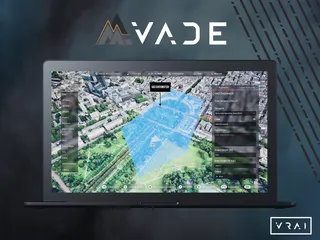Beyond Operational AI: APATS 2025 Preview Explores Data, Regulation & Human Factors
Contact Our Team
For more information about how Halldale can add value to your marketing and promotional campaigns or to discuss event exhibitor and sponsorship opportunities, contact our team to find out more
The America's -
holly.foster@halldale.com
Rest of World -
jeremy@halldale.com
With over 200 AI projects currently underway in aviation training worldwide, the sector's engagement with artificial intelligence extends far beyond the operational applications that dominate industry headlines. Yet this substantial activity remains largely invisible, creating a significant knowledge gap that could hinder effective implementation across the sector.
In the latest episode of Halldale's AI in Action podcast, titled "Beyond Operational AI: Data, Regulation & Human Factors in Focus at APATS 2025," our special correspondent, Andy Fawkes, leads an APATS preview discussion that addresses this hidden landscape.
Joined by Halldale Group Editor Marty Kauchak, Cedric Paillard (COO of Airline Pilot Club), and Dr. Kevin Verdiere (Head of Product at Hinfact), the panel explores the practical realities facing training organisations: the data foundation challenges that many overlook, the evolving regulatory frameworks creating both opportunities and uncertainty, and the human factors considerations that will ultimately determine AI's success in training environments.
APATS 2025 returns to Marina Bay Sands, Singapore, on 26th and 27th August. Now in its 21st year, the event will feature comprehensive sessions across pilot, cabin crew, maintenance technician, and Approved Training Organisation (ATO) streams. A key focus will be two workshops, including a dedicated "AI in Training" session led by Cedric Paillard.
Register for APATS 2025!The Training Challenge: Beyond Operational Applications
Whilst AI applications in aviation operations and maintenance receive considerable attention, the training sector's engagement with AI remains less visible. Cedric Paillard said: "We've counted about 200, 250 projects around aviation in training all around the world," pointing to substantial activity that often goes unrecognised in broader industry discussions.
The upcoming APATS AI workshop, that Cedric will run, seeks to address this by clarifying AI terminology and providing practical implementation frameworks. The session encourages attendees to bring their own AI project concepts for collaborative problem-solving, ensuring direct relevance to their organisational contexts.
Regulatory Landscape: Progress Amid Uncertainty
The regulatory environment presents both challenges and emerging clarity. Common global issues include data structuring, privacy protection, and managing risks associated with AI-generated misinformation or bias. Whilst cultural differences exist in regulatory approaches - with the panel acknowledging Europe (EASA) appearing somewhat ahead of the US (FAA) in AI training applications - the experts anticipate gradual harmonisation.
Cedric notes the evolving EASA framework for AI deployment in aviation training, with workshop attendees receiving early insights into these developments. However, the panel acknowledges that regulatory frameworks remain works in progress, requiring ongoing adaptation as the technology matures.
Learn More About The APATS AI in Aviation WorkshopThe Data Foundation Problem
Dr. Kevin Verdiere of Hinfact, a company specialising in human factors research, identifies a fundamental challenge: the industry's historical reliance on manual processes. "The world of training was mostly pen and papers," he explains, with many organisations still dependent on Excel spreadsheets for data management.
This legacy creates significant obstacles for effective AI implementation. Hinfact's response has been to develop a comprehensive training management system (TMS) designed to facilitate the "digital transition" by enabling structured data capture from the outset. This approach, Kevin argues, is essential for realising AI's potential benefits, from automated reporting to adaptive training recommendations.
The discussion also distinguishes between subjective data (instructor observations) and objective data (physiological measurements, simulator-derived metrics). Whilst objective data offers considerable future potential, Kevin notes that the industry's inherently cautious adoption processes mean widespread integration remains "still a few years" away, requiring substantial cultural and procedural changes.
AI as Enhancement, Not Replacement
Perhaps the most significant insight concerns AI's proper role in training environments. Kevin's analogy proves instructive: "We think AI can be a very strong MRI or scan, but you need a doctor to put the diagnosis." He emphasises that AI, through platforms like Hinfact's, applies pre-defined knowledge and analytical frameworks to data - it does not make independent judgements about pilot competency.
Instead, AI serves as a sophisticated tool that enhances instructor capabilities, automating the measurement of technical procedures whilst allowing instructors to focus on crucial non-technical skills such as communication and leadership development.
Looking Forward: The Need for Cross-Industry Dialogue
Ahead of APATS, Marty Kauchak emphasises the importance of increased collaboration between experts across civil aviation, military, and other high-risk industries regarding AI applications. Through platforms like the "AI in Action" podcast and events such as APATS, Halldale aims to facilitate this essential dialogue.
The challenges facing AI adoption in training are significant: legacy systems, regulatory uncertainty, cultural resistance, and the fundamental need for robust data foundations.
APATS 2025 will provide a forum for practitioners to share experiences, examine practical solutions, and build the cross-industry connections necessary for thoughtful AI adoption in training environments. We look forward to hearing your views in Singapore!


